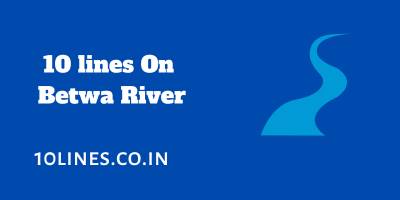10 lines On Betwa River Are you a high school or college student looking for a ten-line essay on India’s famous river Betwa? We have given three separate pieces of facts regarding the Betwa here. The three groups are based on the degree of comprehension of children, school pupils, and high school students.

10 lines On Betwa River For Children And Students
Here you will find a wealth of information about Betwa, such as its origin, length, tributary rivers, cultural significance, and so on.
Betwa is a river in northern India that goes through Madhya Pradesh and Uttar Pradesh. The river is an important supply of water for the communities that live along its banks. The river is used for a variety of functions provides a lifeline for its inhibitors. The river runs through several prominent Indian cities and has a significant impact on their life.
To learn more about the holy river Betwa, it is best to read the entire article.
Set 1] 10 Lines On River Betwa For Children:
1] Betwa is an Indian river that flows through the states of Madhya Pradesh and Uttar Pradesh.
2] In Sanskrit, the river is known as the Vetravati.
3] The river extends 590 kilometres from its source to where it joins the Yamuna.
4] The river rises in the Vindhya Mountains at Kumragaon Village in Raisen, Madhya Pradesh, India.
5] It empties into the Yamuna near Hamirpur, Uttar Pradesh, India.
6] Bina, Dhasaan, Jamni, and others are among the 14 major tributaries of the Betwa River.
7] The river flows through the cities of Vidisha, Sanchi, Orchha, and Hamirpur.
8] The Betwa River flows mainly northeast from its headwaters to its mouth.
9] The famous well-known Ram Raja Mandir is located on the banks of the Betwa River.
10] The Indian Navy’s ‘INS Betwa’ frigate was named in honour of this river.
Set 2] 10 Lines On River Betwa For School Students:
1] The Betwa River is a river in northern India that flows from the Vindhya Mountains near Hoshangabad, Madhya Pradesh.
2] The Betwa flows across Central and Northern India.
3] The Betwa is 590 kilometres long, with 39% in Madhya Pradesh and the remaining 60% in Uttar Pradesh.
4] In the epic Mahabharata, “Betwa” is referred to as Vetravati.
5] The Betwa basin is surrounded by sandstone hills.
6] Over half of its route is not navigable due to the Malwa Plateau.
7] In the 17th century, the Jahangir Mahal was built on the banks of the Betwa River at Orchha.
8] Clay, Silty Clay, Clay Loam, and Sandy Loam are the soil types found in the Betwa river basin.
9] The capital of the Chedi Kingdom, a significant historic site, was constructed on Betwa bank.
10] Betwa river linking is India’s and Madhya Pradesh’s first river-link project.
Set 3] 10 Lines On River Betwa For College Students:
1] Betwa is a large river in northern and central India that flows through Madhya Pradesh and Uttar Pradesh.
2] The source of the Betwa River is located in the Vindhya Mountains, 576 metres above sea level.
3] The Betwa basin catchment area covers 43895 square kilometres, 69% of which is in Madhya Pradesh and the remainder in Uttar Pradesh.
4] From its source, It traverses 590 kilometres before meeting the Yamuna near Orchha in the Uttar Pradesh town of Hamirpur.
5] Some of the significant dams across the Betwa basin are Dhurwara Dam, Rajghat Dam, Parichha Dam, Matatila Dam, Halali Dam.
6] On the Betwa River stands the Rajghat Dam, an interstate dam project of the governments of Madhya Pradesh and Uttar Pradesh.
7] The Betwa River in Uttar Pradesh is designated as a National Waterway (NW-19).
8] The festivals of Namaste Orcha and Prakatya Parva are held on the banks of the Betwa River.
9] Municipal sewage and agricultural drains are two of the most significant polluters of the Betwa River.
10] It is the lifeline of Orchha because it provides a livelihood for the people that live there.
Readers, thank you for reading ’10 Lines on the Betwa’. We hope you found the information above useful, and that you liked reading it. We tried to convey this information in a simple and easy-to-remember language. This knowledge may be used for project work, homework, test preparation, and speeches.